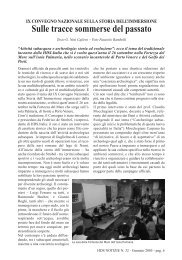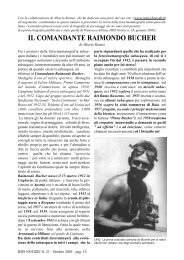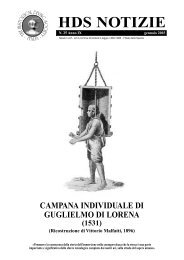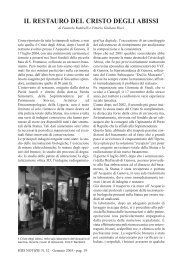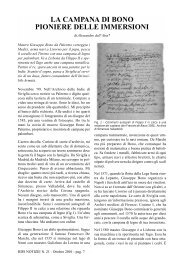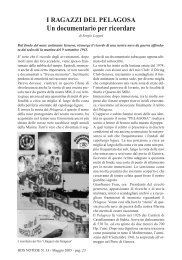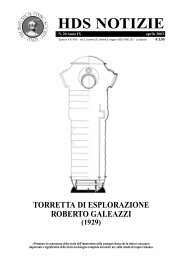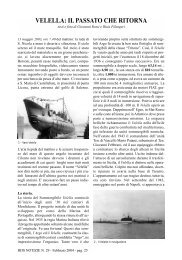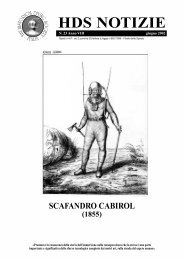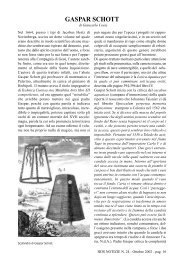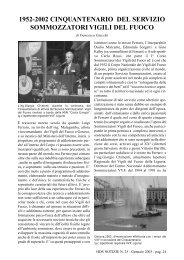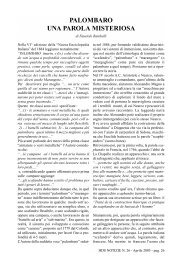HDS NOTIZIE N. 27 - Luglio 2003 - Historical Diving Society Italia
HDS NOTIZIE N. 27 - Luglio 2003 - Historical Diving Society Italia
HDS NOTIZIE N. 27 - Luglio 2003 - Historical Diving Society Italia
You also want an ePaper? Increase the reach of your titles
YUMPU automatically turns print PDFs into web optimized ePapers that Google loves.
“HICHTYOSANDRE” L’ARO-SCAFANDRO DI<br />
TOUBOULIC del 1808 – NUOVE SCOPERTE<br />
di Daniel David e Faustolo Rambelli – disegni di Daniel David<br />
La ricerca, in qualsiasi campo essa sia applicata<br />
porta, il più delle volte, a risultati positivi che non<br />
solo integrano le conoscenze fino a quel momento<br />
acquisite, ma talvolta ne modificano sostanzialmente<br />
i contenuti.<br />
Nel numero 18, gennaio 2001, di <strong>HDS</strong> <strong>NOTIZIE</strong><br />
è apparso un vecchio articolo, del 1977, di Daniel<br />
David dal titolo “L’Hichtyosandre di P.M.<br />
Touboulic – 1808, forse il primo apparecchio<br />
d’immersione ad ossigeno” che portava a conoscenza<br />
dei lettori la scoperta, da parte dell’autore,<br />
dei documenti del brevetto relativi all’autorespiratore<br />
ad ossigeno (ARO) inventato e brevettato<br />
da Touboulic nel 1808, all’età di 26 anni, illustrandone<br />
le caratteristiche.<br />
Ma perché quel “forse” nel titolo?<br />
Semplicemente per il fatto che i documenti allora<br />
recuperati, relativi al brevetto dell’apparecchio di<br />
cui si sta parlando, non contenevano l’evidenza<br />
che lo stesso fosse stato effettivamente costruito<br />
ed utilizzato, anche solo per prove e collaudi.<br />
Ora, dopo circa 25 anni, presso l’INPI (Institut<br />
National de la Proprietè Industrielle) di Parigi,<br />
sono state rintracciate 2 lettere, datate 03 marzo e<br />
30 maggio 1808, indirizzate al Ministro<br />
dell’Interno, con cui Touboulic sollecitava il rilascio<br />
del brevetto del suo ARO con relativa privativa<br />
industriale.<br />
I contenuti delle due lettere ci danno sia l’evidenza<br />
della realizzazione, funzionalità e operatività<br />
del suo ARO-scafandro e sia gli elementi per<br />
apportare una piccola modifica al disegno dello<br />
scafandro realizzato da David nel 1977.<br />
Touboulic, nella prima lettera, spiega innanzitutto<br />
che il motivo che lo ha spinto a realizzare<br />
l’HICHTYOSANDRE è di eliminare quelli che<br />
lui ritiene siano gli inconvenienti e pericoli dell’immersione<br />
con la “campana” e con lo “scafandro<br />
a tube” di Chevalier de Beauve allora maggiormente<br />
in uso. Inconvenienti che vuole evitare<br />
fornendo al suo palombaro:<br />
aria fresca in modo autonomo, senza l’aiuto<br />
esterno;<br />
la possibilità di spostarsi sul fondale ed usare<br />
<strong>HDS</strong> <strong>NOTIZIE</strong> N. <strong>27</strong> - <strong>Luglio</strong> <strong>2003</strong> - pag. 15<br />
“HICHTYOSANDRE”<br />
THE ARO-DIVING SUIT OF<br />
TOUBOULIC IN 1808 – NEW<br />
DISCOVERIES<br />
by Daniel David and Faustolo Rambelli –<br />
Drawings: Daniel David<br />
Translation of Barbara Camanzi & Lisa Borghesi<br />
In every field it is applied, the research usually<br />
results in a positve outcome that not only integrates<br />
with exisiting knowledge but can also substantially<br />
change it.<br />
In <strong>HDS</strong> News n. 18, January 2001 in an article<br />
dated 1977 by Daniel David and titled “The<br />
Hichtyosandre of P.M. Touboulic – 1808, probably<br />
the first diving oxygen apparatus” appeared which<br />
announced the discovery by David of patent documents<br />
for the autonomous oxygen rebreather<br />
(ARO) illustrating its characteristics. Touboulic<br />
invented and patented it in 1808, when he was 26<br />
years old.<br />
But why that “probably” in the title? Simply<br />
because the documents that had just been found on<br />
the patent for the apparatus we are talking about,<br />
did not contain the evidence that this apparatus<br />
was ever built and used, even as a trial or for<br />
testing purposes.<br />
Today, after approximately 25 years, at the INPI<br />
(Institut National de la Proprietè Industrielle) in<br />
Paris, two letters have been found, dated 3 March<br />
and 30 May 1808, addressed to the Home Office<br />
and in which Touboulic was pressing for the issue<br />
of the patent on his ARO together with the related<br />
patent right. Now the contents of these letters give<br />
us the evidence of the realization, functionality<br />
and operation of his ARO-diving suit and even the<br />
elements for bringing a small modification to the<br />
diving suit that was designed by David in 1977.<br />
Touboulic, in the first letter, explains first of all<br />
that the motivation that pushed him to realise the<br />
HICHTYOSANDRE was to eliminate what he<br />
considered the disadvantages and dangers of dives<br />
carried out with the “bell” and the “diving suit<br />
with hoses” by Chevalier de Beauve, the most<br />
widely used in those days. He wanted to avoid



